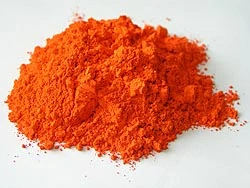Lead tetraoxide[]
Formula: Pb3O4[]
Synonyms: Lead minium, Minium, Triplumbic tetroxide, Red lead, Lead tetroxide
Description: Lead tetraoxide is primarly used to make crackling microstars . The composition is very sensitive, explosive and poisonous. It is in fact one of the most dangerous compounds used commonly in modern pyrotechnics. Alternative crackling mixtures e.g. based on bismuth trioxide exist (which is less poisonous), but the high price of bismuth trioxide generally restricts its use. Together with ferro-silicon minium is the original "red thermite".
Hazards: Lead tetraoxide, like most lead compounds, is extremely poisonous. Lead is an accumulative neurotoxin and extreme care should be taken to prevent direct contact. Lead tetraoxide may be absorbed by inhalation and ingestion. Wear a respirator, gloves, and protective clothing.
Sources: Lead tetraoxide may be prepared from a solution of lead nitrate and sodium hydroxide . Note that the procedure involves extremely corrosive and poisonous chemicals and should only be attempted by those who have access to (and know how to use) the right equipment and can handle the waste properly. Prepare a concentrated solution of sodium hydroxide by dissolving 300 grams of sodium hydroxide in water. The solution will heat up during this. To prevent it from boiling suddenly add only small portions at a time. When all has dissolved, allow it to cool down to room temperature. Dissolve 50 grams of lead nitrate in 200 ml of water, and slowly add the sodium hydroxide solution to this solution while stirring continuesly. A white precipitate will form first, which will turn orange when all sodium hydroxide solution has been added. Stir this solution well for another hour, and then allow the lead tetraoxide to settle. Carefully decant the supernatant, add boiling hot water to the residue, stir, allow to settle and decant again. Repeat this 5 more times. Then filter and rinse the lead tetraoxide in the filter several times with hot water.
Hazard Symbols: T, N
